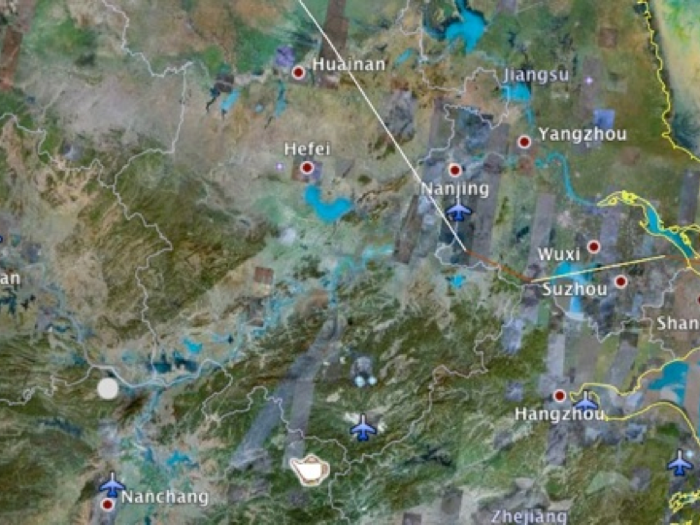
Nanjing is 1200 km North East of Hong Kong, 800 km almost due south of Beijing, A line drawn from Shanghai to Xian goes through Nanjing. It is 1000km ESE of Xi’an and 270km from Shanghai on that line. Shanghai is due west of the southern tip of mainland Japan. The big river (da he) you can see above is the Yang-Tse, some 2 (±0.5) km wide at this point.
Much is made on television of the Sino-Japanese war that began in 1937, although it had been running in an underground fashion since probably 1930 as an indirect effect of the economic crash. Japan needed land and saw a source of supply across the water. Defeating Shanghai went much more (6 months or so) slowly than expected so the Japanese were in a bad mood when they left for Nanjing, then the national capital. The city folded without a fight of any significance due to weird instructions from Chang Kai-Shek, possibly believing Japanese propaganda about good treatment, which turned out to be very far from the actuality. The populace was defeated and submissive in a way westerners cannot believe. Over the next 6 weeks the Japanese killed well over 200,000 people, half of the half that didn’t escape. This is the Rape of Nanking, which should be better known.
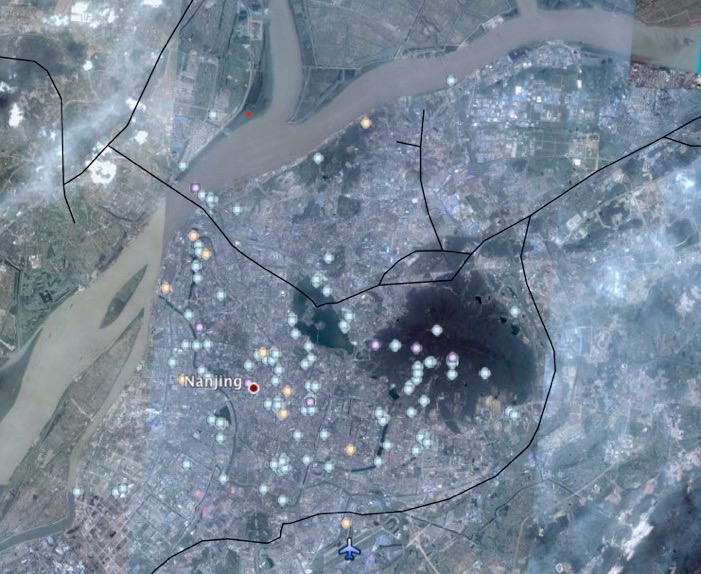
Wikipedia says this: see http://en.wikipedia.org/wiki/Nanking_Massacre for the full article.
For Iris Chang's book, see The Rape of Nanking (book). It is well worth reading: I have had a copy. Had: I can no longer find it, 201005. Wikipedia says:
The Nanking Massacre, commonly known as the Rape of Nanking, because many local women were raped, was an infamous war crime committed by the Japanese military in Nanjing (historically known as Nanking), then the capital of the Republic of China, after it fell to the Imperial Japanese Army on December 13, 1937. The duration of the massacre is not clearly defined, although the violence lasted well into the next six weeks, until early February 1938.
During the raping of Nanking, the Japanese army committed numerous atrocities, such as rape, looting, arson and the execution of prisoners of war and civilians. Although the executions began under the pretext of eliminating Chinese soldiers disguised as civilians, it is claimed that a large number of innocent men were intentionally identified as enemy combatants and executed as the massacre gathered momentum. A large number of women and children were also killed, as rape and murder became more widespread.
According to the International Military Tribunal for the Far East, estimates made at a later date indicate that the total number of civilians and prisoners of war murdered in Nanking and its vicinity during the first six weeks of the Japanese occupation was over 200,000. That these estimates are not exaggerated is borne out by the fact that burial societies and other organisations counted more than 155,000 buried bodies. Most were bound with their hands tied behind their backs. These figures do not take into account those persons whose bodies were destroyed by burning, by throwing them into the Yangtze River, or otherwise disposed of by the Japanese.[1] The extent of the atrocities is debated between China and Japan, with numbers[2] ranging from some Japanese claims of several hundred,[3] to the Chinese claim of a non-combatant death toll of 300,000[4]. A number of Japanese researchers consider 100,000 – 200,000 to be an approximate value.[5] Other nations usually believe the death toll to be between 150,000–300,000.[6] This number was first promulgated in January of 1938 by Harold Timperly, a journalist in China during the Japanese invasion, based on reports from contemporary eyewitnesses. Other sources, including Iris Chang's The Rape of Nanking, also conclude that the death toll reached 300,000. In December 2007, newly declassified U.S. government documents revealed an additional toll of around 500,000 in the area surrounding Nanking before it was occupied.[7]
In addition to the number of victims, some Japanese nationalists have even disputed whether the atrocity ever happened.[8] While the Japanese government has acknowledged the incident did occur,[9] some Japanese nationalists have argued, partly using the Imperial Japanese Army's claims at the International Military Tribunal for the Far East, that the death toll was military in nature and that no such civilian atrocities ever occurred. This claim has been criticised by various figures, citing statements of non-Chinese at the Tribunal, other eyewitnesses and by photographic and archaeological evidence that civilian deaths did occur.
Condemnation of the massacre is a major focal point of Chinese nationalism. In Japan, however, public opinion over the severity of the massacre remains widely divided — this is evidenced by the fact that whereas some Japanese commentators refer to it as the 'Nanking massacre' (南京大虐殺 Nankin daigyakusatsu?), others use the more ambivalent term 'Nanking Incident' (南京事件 Nankin jiken?). However, this term can also refer to a separate Nanjing Incident that occurred during the 1927 Nationalist seizure of the city as a part of the Northern Expedition, in which foreigners in the city were attacked. The 1937 massacre and the extent of its coverage in school textbooks continues to be a point of contention and controversy in Sino-Japanese relations.
Having read Iris Chang’s book, I think that not only is the Japanese propaganda wrong but that the death toll was very much higher, more like 400,000 in Nanjing and a similar number outside the city. Whatever the numbers, it was a gross violation of a people that were not resisting and shows serious flaws in the Japanese national character of the time. It is quite clear that the Nipponese did not think of the Chinese as people – somehow they themselves were exceptions and thus the only humans. This is extreme nationalism, to claim that those not of the People not the same are more than not-people, they are not-human. There is enough evidence now outside China to render all apologists struggling to cry “conspiracy theory” silent. This goes a long way to explaining the Chinese racist tendencies, their automatic hatred of Japanese people and their latent distrust of promises. It may explain why no deal is ever completely agreed until after it is finished. Which serves to remind readers that these pages reflect my opinions.
Nanjing is the capital of China's Jiangsu Province, and a city with a prominent place in Chinese history and culture. Nanjing (literally: 'Southern capital') served as the capital of China during several historical periods, including as the former capital city of Republic of China, and is listed as one of the Four Great Ancient Capitals of China: Beijing % dynasties and especially 1644 to 1912 and after 1949, Nanjing (6 dynasties, including 1946-9), Luoyang (5 dynasties), and Chang'an (Xi'an, 9 dynasties and most of 221BC to 907 AD). Nanjing is also one of the fifteen sub-provincial cities in the People's Republic of China's administrative structure, enjoying jurisdictional and economic autonomy only slightly less than that of a province. In addition, the Republic of China claims it as its de jure capital.
Located in the downstream Yangtze River drainage basin and Yangtze River Delta economic zone, Nanjing has always been one of China's most important cities. Apart from having been the capital of China for six dynasties and of the Republic of China, Nanjing has also served as a national hub of education, research, transportation and tourism throughout history. With an urban population of over five million, it is also the second largest commercial centre in the East China region, behind only Shanghai. Also Wikipedia....
Here is an oblique of Nanjing, facing east to the sea. It shows the Yangtse, the Purple Mountain (Zhong Shan) and (on the right) the Lake, XuanWu Hu; on the left edge is the river and the little hill beside it is Qixia Shan; the distant range may be the BaoHuaShan nature reserve.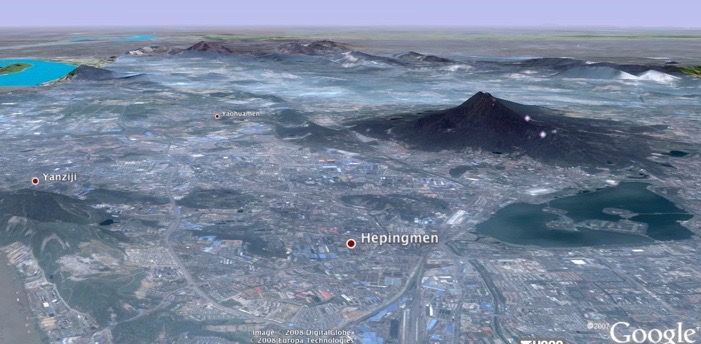
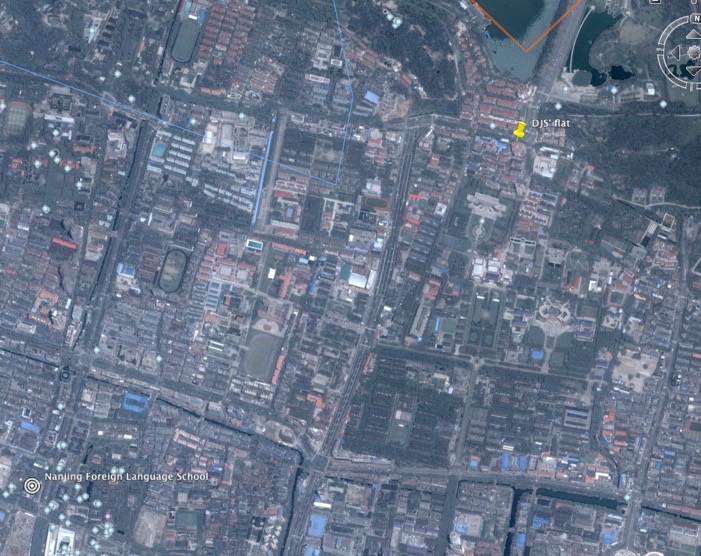
My apartment is near the junction of lake and mountain, the tall red and white building on the corner, at the low centre of the picture below….
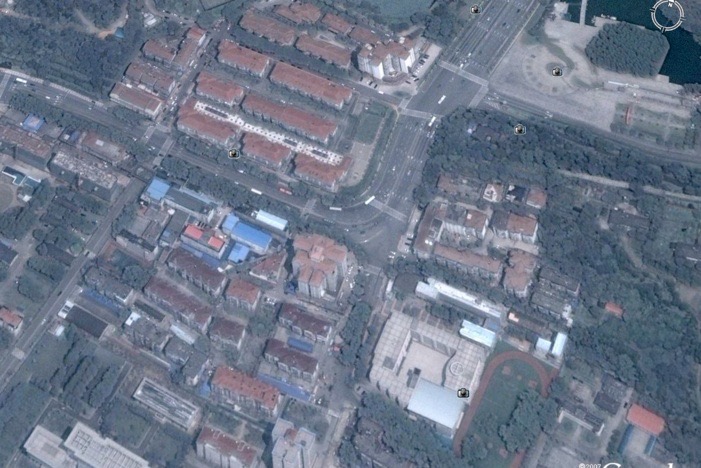
and here is School, too, both labelled on this Google Earth map. More to follow perhaps as I glean things worth sharing. Right now, it is important that the area is earthquake free.
Copied from http://www.echinacities.com/cityguide/nanjing/Liv/ with [inserted comments]
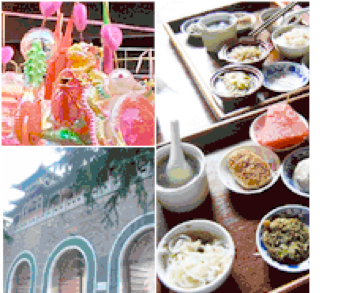
It is little wonder that Nanjing, the "Southern Capital", was once chosen as the seat of China's imperial power and remained so through six dynasties. Nanjing's rich cultural, artistic and military history have lent it a reputation as a "scholar's city" that stays with it even today. Legend has it that Lord Fu Chai of the Wu State created Nanjing, then under the name Yecheng, in 495 BC.
Present day Nanjing is home to over 5 million inhabitants, including a small but growing expatriate population. Residents will tell you that Nanjing possesses the best aspects of both Beijing and Shanghai without the furore and hubbub of big city life. Like Beijing, Nanjing's heritage as a centre of politics and learning has carried over into the modern atmosphere. The Mausoleum of Dr. Sun Yat-sen and the Nanjing Library—the third largest in the country—are partially responsible for the local flavour. Like Shanghai, large shopping districts offer a full range of contemporary amenities, and skyscrapers tower out of the city centre. Unlike either city, however, pollution is tolerable, the streets are lined with greenery, and the cost of living is manageably low.
Though Nanjing is situated only two hours northwest of Shanghai (by car), the city's pace and architecture is on a different scale altogether. Rows of towering trees that bloom green and pink in summer dot many city boulevards. Lakes and preserved green space, such as Lover's Park with its famous tulip field, are numerous. The Yangtze River cups Nanjing's western edge, giving locals the choice between the lush riverbank or the historical mountainous regions to the east. Moreover, China's eastern coast is but a half-day drive away. Nanjing's architecture is perhaps more varied than other Chinese cities of its size, with glass-panelled commercial buildings, districts of ancient Chinese temples and traditional housing, and some edifices bearing distinctly European influences.
Weather is liveable, if not great. January is the coldest month of the year, with average lows of -2C (28.4F). Snow, if it occurs at all, is infrequent. The weather heats up from July-August, with average highs of 33C (92F). Because of heavy rainfall in late spring and early summer and Nanjing's position between the coast and a major river, these steamy months can get exceptionally humid. The heaviest rainfall typically occurs in July, with the clouds letting go an average of 175/180mm (7.0/7.1in) over the month.
Dining, nightlife and shopping options are abundant—though those who don't enjoy Chinese food will find themselves visiting the same three or four places repeatedly—and the active entertainment districts are clustered on or near to Zhongshan Road [10 minutes walk from school], the north-south artery. The most popular nightlife can be found in the 1912 District [literally across the road from school] which is teeming with the young and hip on any given weekend. Its shopping equivalent is located in the Fuzimiao (Confucius Temple) area, which is situated along a waterway surrounded by dazzlingly lit historic buildings whose glow is reflected on the surface of Qinhuai River.
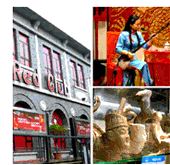
Expatriate resources, while not overly abundant, are perfectly sufficient for daily needs. Several major hotel chains have taken root in Nanjing, including the Sheraton, Sofitel, and the Ramada, which provide drinking, dining, and serviced living options at a price. The city is also home to several reputable international schools [oh, that includes us] and a branch of the International SOS clinic. The Nanjing branches of mega-supermarkets Aochan, Carrefour and Metro each stock a healthy selection of imported goods from all over the world.
DJS 20090730 (ish)